Strategic Leadership Plan: Personal Leadership Development Plan
VerifiedAdded on 2023/06/10
|11
|2894
|146
Report
AI Summary
This report presents a strategic leadership plan designed for personal and professional development. It begins by outlining the essential characteristics of a good leader, including communication skills, influence, independent thinking, conflict resolution, and team building. The plan then analyzes the strengths and weaknesses of leadership and stakeholder management, covering aspects like innovation, active listening, decision-making skills, and potential pitfalls like being overcritical or failing to set clear expectations. Finally, it details a comprehensive leadership skills development plan, emphasizing the importance of active listening, knowledge expansion, mentorship culture, and time management, with actionable steps for assessment, goal setting, and training. This plan aims to cultivate a culture of effective leadership within an organization, leading to improved business results, innovation, employee engagement, and strategic alignment. Desklib provides access to similar solved assignments.
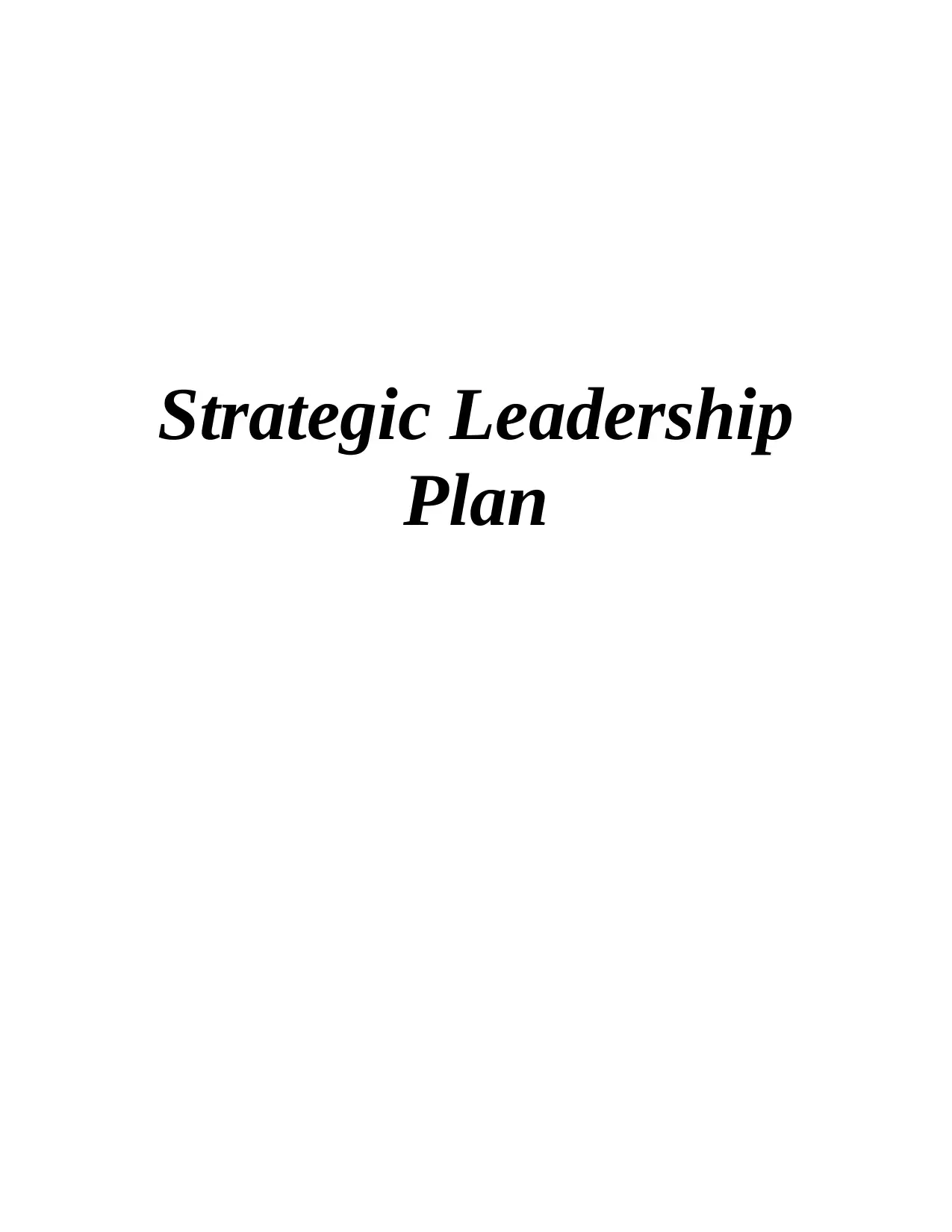
Strategic Leadership
Plan
Plan
Paraphrase This Document
Need a fresh take? Get an instant paraphrase of this document with our AI Paraphraser
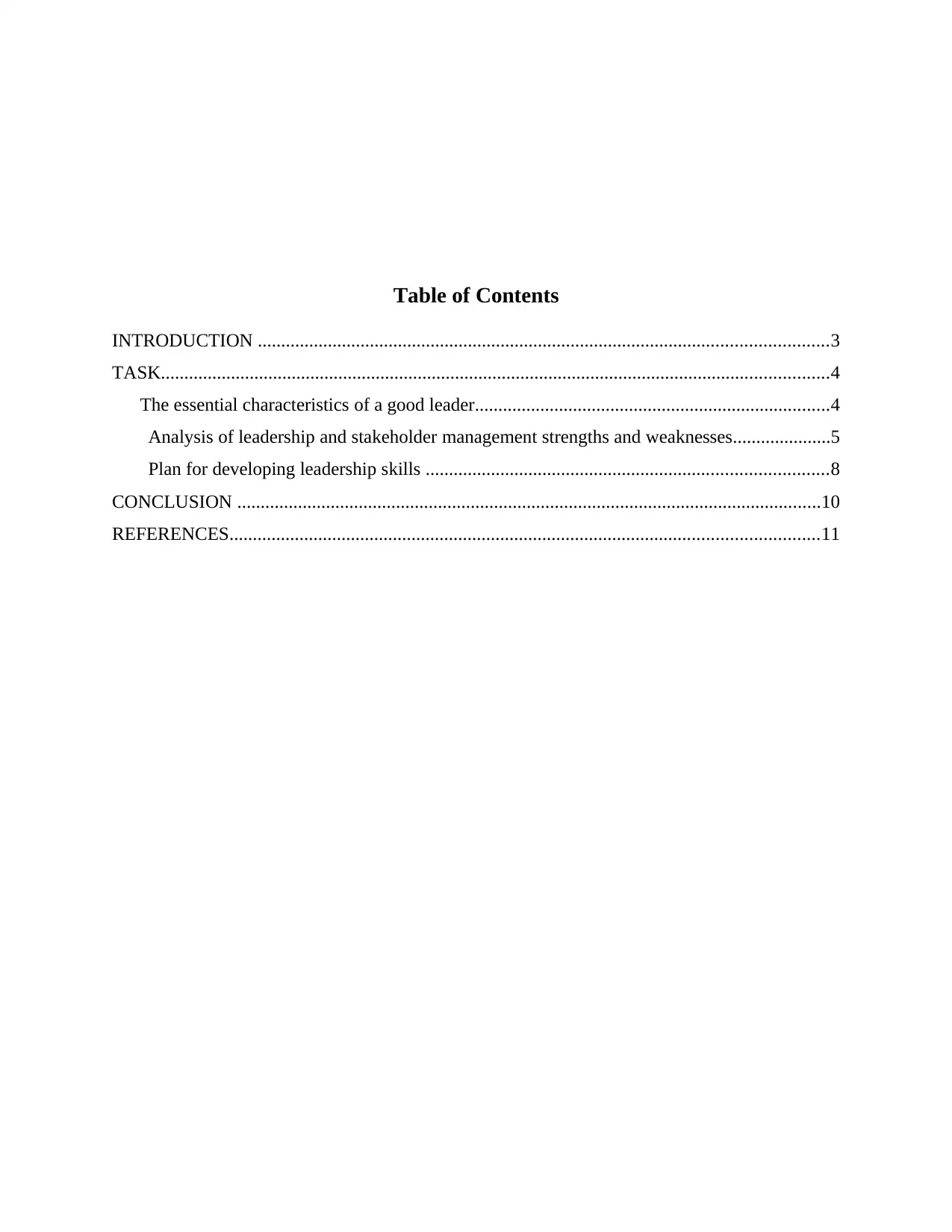
Table of Contents
INTRODUCTION ..........................................................................................................................3
TASK...............................................................................................................................................4
The essential characteristics of a good leader............................................................................4
Analysis of leadership and stakeholder management strengths and weaknesses.....................5
Plan for developing leadership skills ......................................................................................8
CONCLUSION .............................................................................................................................10
REFERENCES..............................................................................................................................11
INTRODUCTION ..........................................................................................................................3
TASK...............................................................................................................................................4
The essential characteristics of a good leader............................................................................4
Analysis of leadership and stakeholder management strengths and weaknesses.....................5
Plan for developing leadership skills ......................................................................................8
CONCLUSION .............................................................................................................................10
REFERENCES..............................................................................................................................11
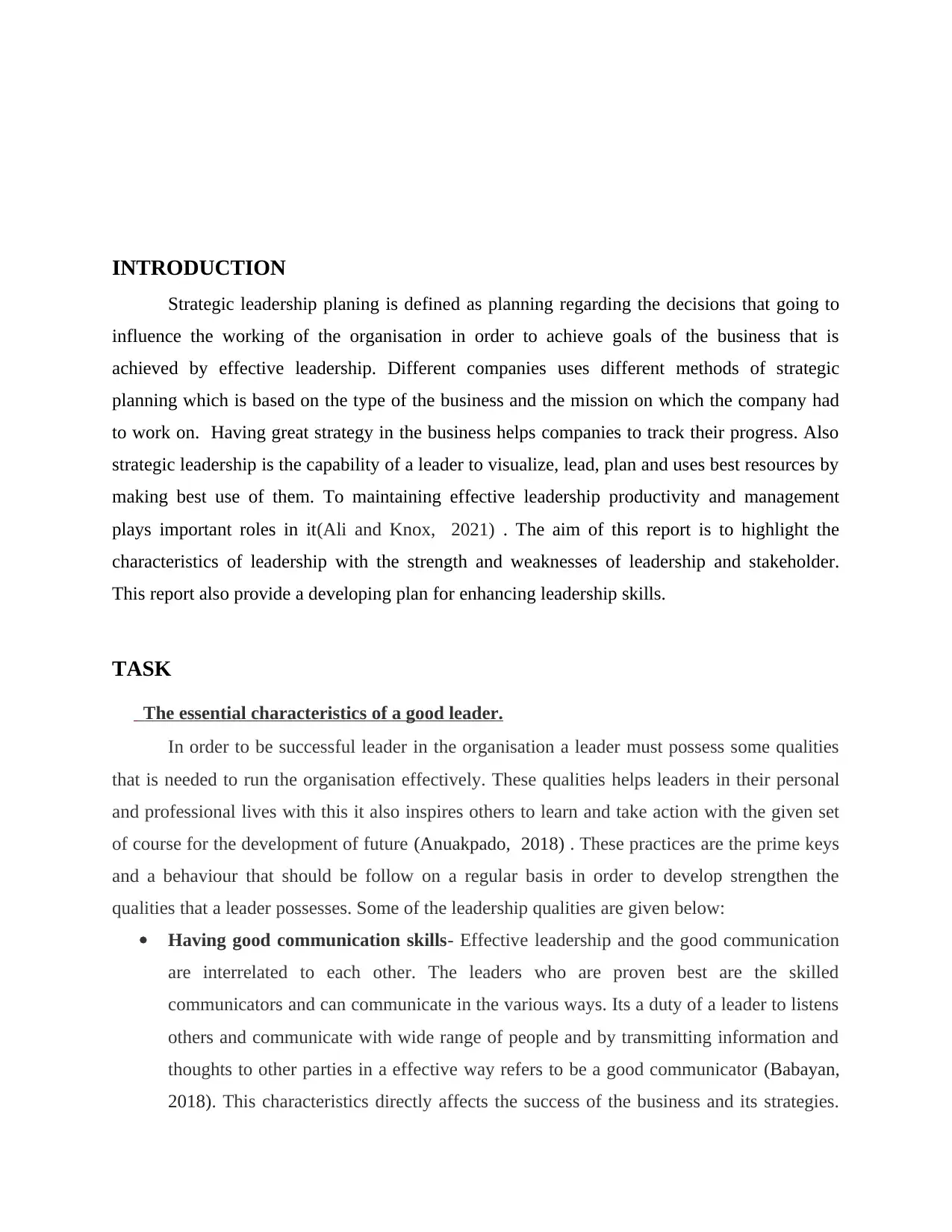
INTRODUCTION
Strategic leadership planing is defined as planning regarding the decisions that going to
influence the working of the organisation in order to achieve goals of the business that is
achieved by effective leadership. Different companies uses different methods of strategic
planning which is based on the type of the business and the mission on which the company had
to work on. Having great strategy in the business helps companies to track their progress. Also
strategic leadership is the capability of a leader to visualize, lead, plan and uses best resources by
making best use of them. To maintaining effective leadership productivity and management
plays important roles in it(Ali and Knox, 2021) . The aim of this report is to highlight the
characteristics of leadership with the strength and weaknesses of leadership and stakeholder.
This report also provide a developing plan for enhancing leadership skills.
TASK
The essential characteristics of a good leader.
In order to be successful leader in the organisation a leader must possess some qualities
that is needed to run the organisation effectively. These qualities helps leaders in their personal
and professional lives with this it also inspires others to learn and take action with the given set
of course for the development of future (Anuakpado, 2018) . These practices are the prime keys
and a behaviour that should be follow on a regular basis in order to develop strengthen the
qualities that a leader possesses. Some of the leadership qualities are given below:
Having good communication skills- Effective leadership and the good communication
are interrelated to each other. The leaders who are proven best are the skilled
communicators and can communicate in the various ways. Its a duty of a leader to listens
others and communicate with wide range of people and by transmitting information and
thoughts to other parties in a effective way refers to be a good communicator (Babayan,
2018). This characteristics directly affects the success of the business and its strategies.
Strategic leadership planing is defined as planning regarding the decisions that going to
influence the working of the organisation in order to achieve goals of the business that is
achieved by effective leadership. Different companies uses different methods of strategic
planning which is based on the type of the business and the mission on which the company had
to work on. Having great strategy in the business helps companies to track their progress. Also
strategic leadership is the capability of a leader to visualize, lead, plan and uses best resources by
making best use of them. To maintaining effective leadership productivity and management
plays important roles in it(Ali and Knox, 2021) . The aim of this report is to highlight the
characteristics of leadership with the strength and weaknesses of leadership and stakeholder.
This report also provide a developing plan for enhancing leadership skills.
TASK
The essential characteristics of a good leader.
In order to be successful leader in the organisation a leader must possess some qualities
that is needed to run the organisation effectively. These qualities helps leaders in their personal
and professional lives with this it also inspires others to learn and take action with the given set
of course for the development of future (Anuakpado, 2018) . These practices are the prime keys
and a behaviour that should be follow on a regular basis in order to develop strengthen the
qualities that a leader possesses. Some of the leadership qualities are given below:
Having good communication skills- Effective leadership and the good communication
are interrelated to each other. The leaders who are proven best are the skilled
communicators and can communicate in the various ways. Its a duty of a leader to listens
others and communicate with wide range of people and by transmitting information and
thoughts to other parties in a effective way refers to be a good communicator (Babayan,
2018). This characteristics directly affects the success of the business and its strategies.
⊘ This is a preview!⊘
Do you want full access?
Subscribe today to unlock all pages.

Trusted by 1+ million students worldwide
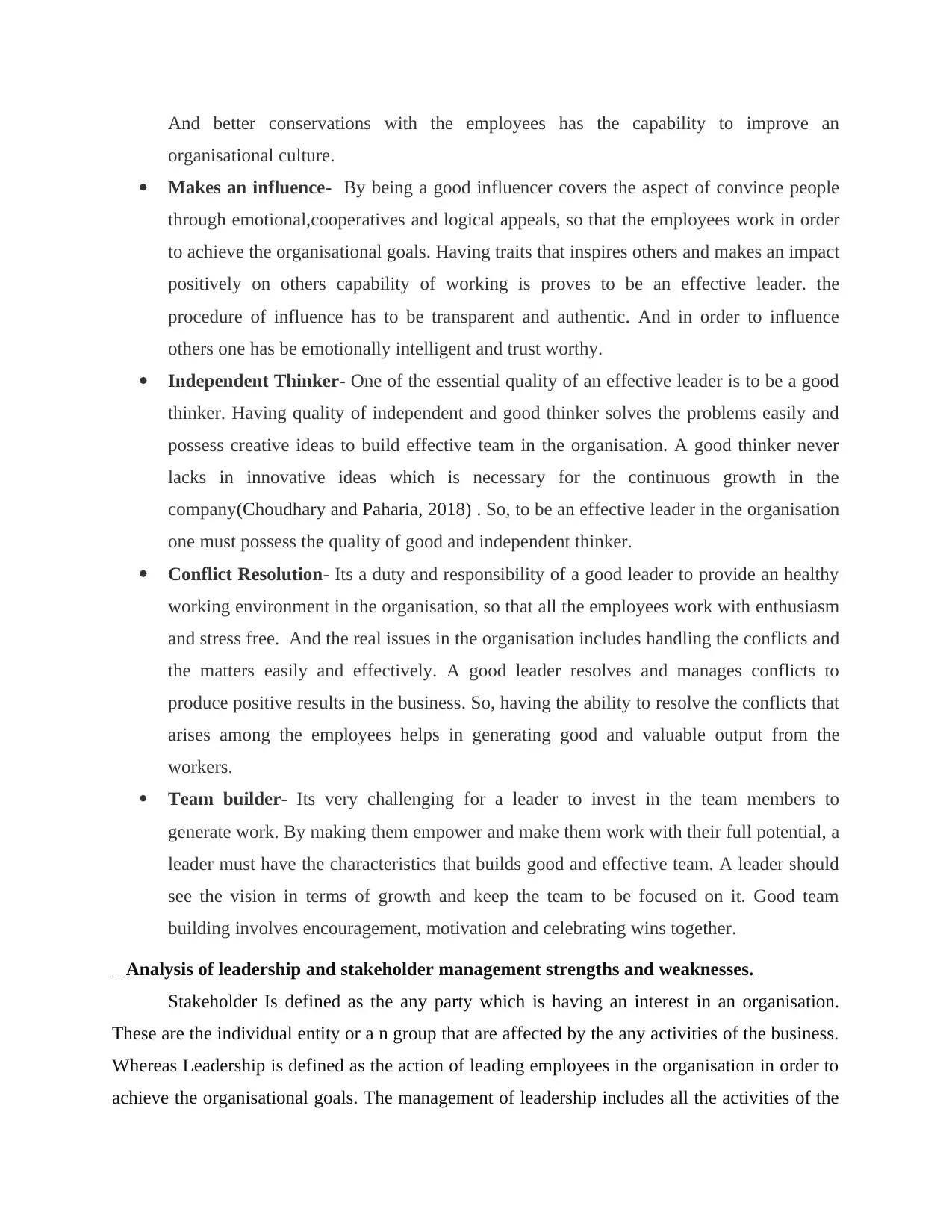
And better conservations with the employees has the capability to improve an
organisational culture.
Makes an influence- By being a good influencer covers the aspect of convince people
through emotional,cooperatives and logical appeals, so that the employees work in order
to achieve the organisational goals. Having traits that inspires others and makes an impact
positively on others capability of working is proves to be an effective leader. the
procedure of influence has to be transparent and authentic. And in order to influence
others one has be emotionally intelligent and trust worthy.
Independent Thinker- One of the essential quality of an effective leader is to be a good
thinker. Having quality of independent and good thinker solves the problems easily and
possess creative ideas to build effective team in the organisation. A good thinker never
lacks in innovative ideas which is necessary for the continuous growth in the
company(Choudhary and Paharia, 2018) . So, to be an effective leader in the organisation
one must possess the quality of good and independent thinker.
Conflict Resolution- Its a duty and responsibility of a good leader to provide an healthy
working environment in the organisation, so that all the employees work with enthusiasm
and stress free. And the real issues in the organisation includes handling the conflicts and
the matters easily and effectively. A good leader resolves and manages conflicts to
produce positive results in the business. So, having the ability to resolve the conflicts that
arises among the employees helps in generating good and valuable output from the
workers.
Team builder- Its very challenging for a leader to invest in the team members to
generate work. By making them empower and make them work with their full potential, a
leader must have the characteristics that builds good and effective team. A leader should
see the vision in terms of growth and keep the team to be focused on it. Good team
building involves encouragement, motivation and celebrating wins together.
Analysis of leadership and stakeholder management strengths and weaknesses.
Stakeholder Is defined as the any party which is having an interest in an organisation.
These are the individual entity or a n group that are affected by the any activities of the business.
Whereas Leadership is defined as the action of leading employees in the organisation in order to
achieve the organisational goals. The management of leadership includes all the activities of the
organisational culture.
Makes an influence- By being a good influencer covers the aspect of convince people
through emotional,cooperatives and logical appeals, so that the employees work in order
to achieve the organisational goals. Having traits that inspires others and makes an impact
positively on others capability of working is proves to be an effective leader. the
procedure of influence has to be transparent and authentic. And in order to influence
others one has be emotionally intelligent and trust worthy.
Independent Thinker- One of the essential quality of an effective leader is to be a good
thinker. Having quality of independent and good thinker solves the problems easily and
possess creative ideas to build effective team in the organisation. A good thinker never
lacks in innovative ideas which is necessary for the continuous growth in the
company(Choudhary and Paharia, 2018) . So, to be an effective leader in the organisation
one must possess the quality of good and independent thinker.
Conflict Resolution- Its a duty and responsibility of a good leader to provide an healthy
working environment in the organisation, so that all the employees work with enthusiasm
and stress free. And the real issues in the organisation includes handling the conflicts and
the matters easily and effectively. A good leader resolves and manages conflicts to
produce positive results in the business. So, having the ability to resolve the conflicts that
arises among the employees helps in generating good and valuable output from the
workers.
Team builder- Its very challenging for a leader to invest in the team members to
generate work. By making them empower and make them work with their full potential, a
leader must have the characteristics that builds good and effective team. A leader should
see the vision in terms of growth and keep the team to be focused on it. Good team
building involves encouragement, motivation and celebrating wins together.
Analysis of leadership and stakeholder management strengths and weaknesses.
Stakeholder Is defined as the any party which is having an interest in an organisation.
These are the individual entity or a n group that are affected by the any activities of the business.
Whereas Leadership is defined as the action of leading employees in the organisation in order to
achieve the organisational goals. The management of leadership includes all the activities of the
Paraphrase This Document
Need a fresh take? Get an instant paraphrase of this document with our AI Paraphraser
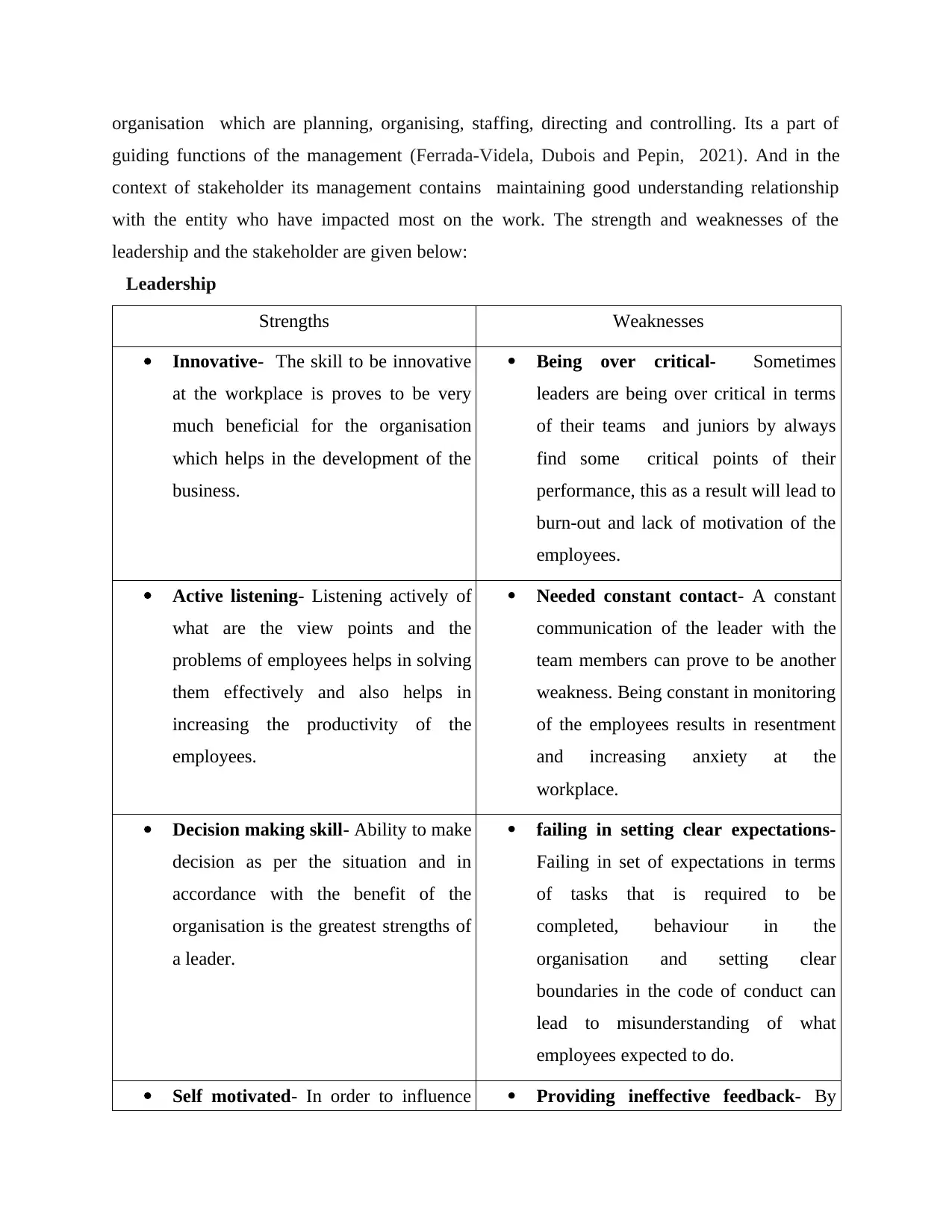
organisation which are planning, organising, staffing, directing and controlling. Its a part of
guiding functions of the management (Ferrada-Videla, Dubois and Pepin, 2021). And in the
context of stakeholder its management contains maintaining good understanding relationship
with the entity who have impacted most on the work. The strength and weaknesses of the
leadership and the stakeholder are given below:
Leadership
Strengths Weaknesses
Innovative- The skill to be innovative
at the workplace is proves to be very
much beneficial for the organisation
which helps in the development of the
business.
Being over critical- Sometimes
leaders are being over critical in terms
of their teams and juniors by always
find some critical points of their
performance, this as a result will lead to
burn-out and lack of motivation of the
employees.
Active listening- Listening actively of
what are the view points and the
problems of employees helps in solving
them effectively and also helps in
increasing the productivity of the
employees.
Needed constant contact- A constant
communication of the leader with the
team members can prove to be another
weakness. Being constant in monitoring
of the employees results in resentment
and increasing anxiety at the
workplace.
Decision making skill- Ability to make
decision as per the situation and in
accordance with the benefit of the
organisation is the greatest strengths of
a leader.
failing in setting clear expectations-
Failing in set of expectations in terms
of tasks that is required to be
completed, behaviour in the
organisation and setting clear
boundaries in the code of conduct can
lead to misunderstanding of what
employees expected to do.
Self motivated- In order to influence Providing ineffective feedback- By
guiding functions of the management (Ferrada-Videla, Dubois and Pepin, 2021). And in the
context of stakeholder its management contains maintaining good understanding relationship
with the entity who have impacted most on the work. The strength and weaknesses of the
leadership and the stakeholder are given below:
Leadership
Strengths Weaknesses
Innovative- The skill to be innovative
at the workplace is proves to be very
much beneficial for the organisation
which helps in the development of the
business.
Being over critical- Sometimes
leaders are being over critical in terms
of their teams and juniors by always
find some critical points of their
performance, this as a result will lead to
burn-out and lack of motivation of the
employees.
Active listening- Listening actively of
what are the view points and the
problems of employees helps in solving
them effectively and also helps in
increasing the productivity of the
employees.
Needed constant contact- A constant
communication of the leader with the
team members can prove to be another
weakness. Being constant in monitoring
of the employees results in resentment
and increasing anxiety at the
workplace.
Decision making skill- Ability to make
decision as per the situation and in
accordance with the benefit of the
organisation is the greatest strengths of
a leader.
failing in setting clear expectations-
Failing in set of expectations in terms
of tasks that is required to be
completed, behaviour in the
organisation and setting clear
boundaries in the code of conduct can
lead to misunderstanding of what
employees expected to do.
Self motivated- In order to influence Providing ineffective feedback- By
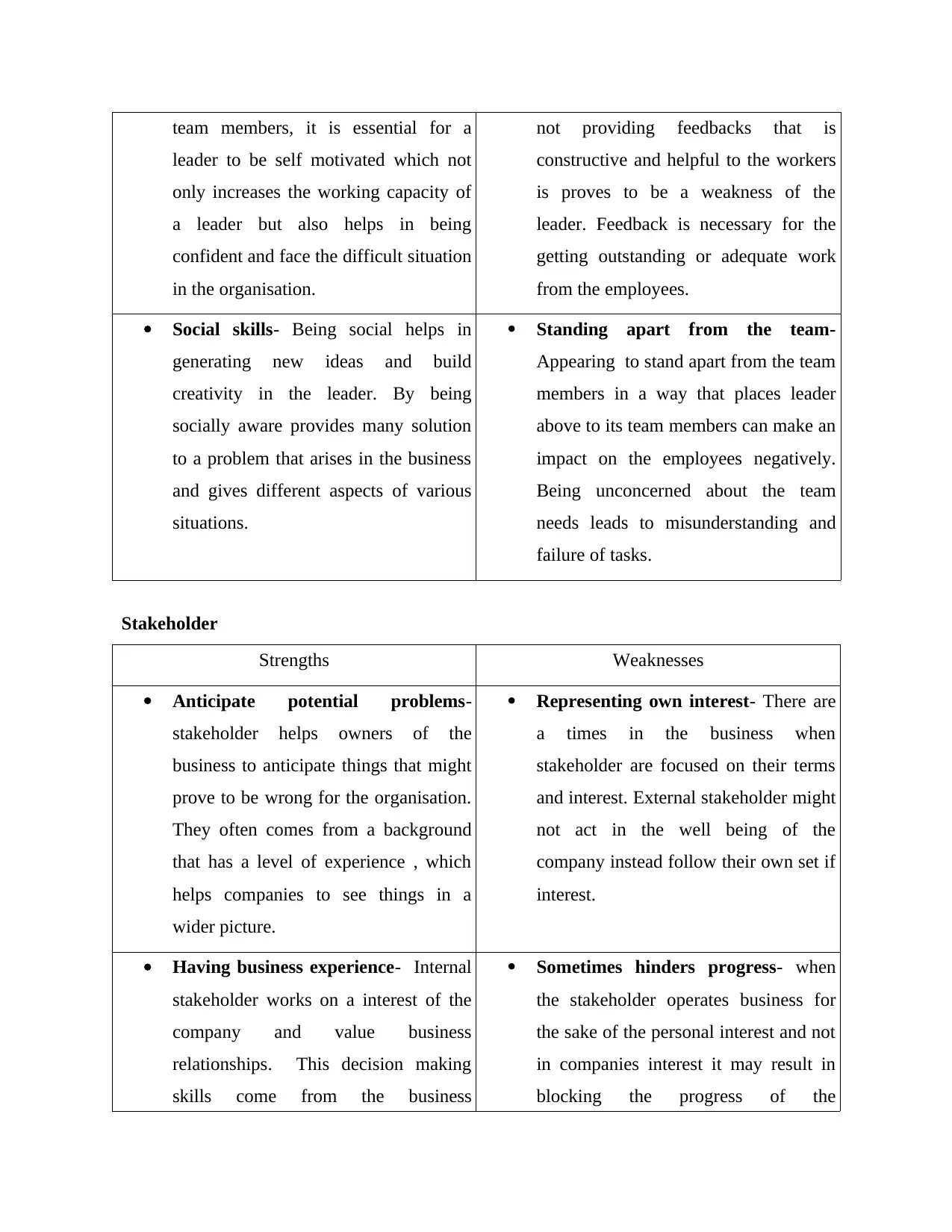
team members, it is essential for a
leader to be self motivated which not
only increases the working capacity of
a leader but also helps in being
confident and face the difficult situation
in the organisation.
not providing feedbacks that is
constructive and helpful to the workers
is proves to be a weakness of the
leader. Feedback is necessary for the
getting outstanding or adequate work
from the employees.
Social skills- Being social helps in
generating new ideas and build
creativity in the leader. By being
socially aware provides many solution
to a problem that arises in the business
and gives different aspects of various
situations.
Standing apart from the team-
Appearing to stand apart from the team
members in a way that places leader
above to its team members can make an
impact on the employees negatively.
Being unconcerned about the team
needs leads to misunderstanding and
failure of tasks.
Stakeholder
Strengths Weaknesses
Anticipate potential problems-
stakeholder helps owners of the
business to anticipate things that might
prove to be wrong for the organisation.
They often comes from a background
that has a level of experience , which
helps companies to see things in a
wider picture.
Representing own interest- There are
a times in the business when
stakeholder are focused on their terms
and interest. External stakeholder might
not act in the well being of the
company instead follow their own set if
interest.
Having business experience- Internal
stakeholder works on a interest of the
company and value business
relationships. This decision making
skills come from the business
Sometimes hinders progress- when
the stakeholder operates business for
the sake of the personal interest and not
in companies interest it may result in
blocking the progress of the
leader to be self motivated which not
only increases the working capacity of
a leader but also helps in being
confident and face the difficult situation
in the organisation.
not providing feedbacks that is
constructive and helpful to the workers
is proves to be a weakness of the
leader. Feedback is necessary for the
getting outstanding or adequate work
from the employees.
Social skills- Being social helps in
generating new ideas and build
creativity in the leader. By being
socially aware provides many solution
to a problem that arises in the business
and gives different aspects of various
situations.
Standing apart from the team-
Appearing to stand apart from the team
members in a way that places leader
above to its team members can make an
impact on the employees negatively.
Being unconcerned about the team
needs leads to misunderstanding and
failure of tasks.
Stakeholder
Strengths Weaknesses
Anticipate potential problems-
stakeholder helps owners of the
business to anticipate things that might
prove to be wrong for the organisation.
They often comes from a background
that has a level of experience , which
helps companies to see things in a
wider picture.
Representing own interest- There are
a times in the business when
stakeholder are focused on their terms
and interest. External stakeholder might
not act in the well being of the
company instead follow their own set if
interest.
Having business experience- Internal
stakeholder works on a interest of the
company and value business
relationships. This decision making
skills come from the business
Sometimes hinders progress- when
the stakeholder operates business for
the sake of the personal interest and not
in companies interest it may result in
blocking the progress of the
⊘ This is a preview!⊘
Do you want full access?
Subscribe today to unlock all pages.

Trusted by 1+ million students worldwide
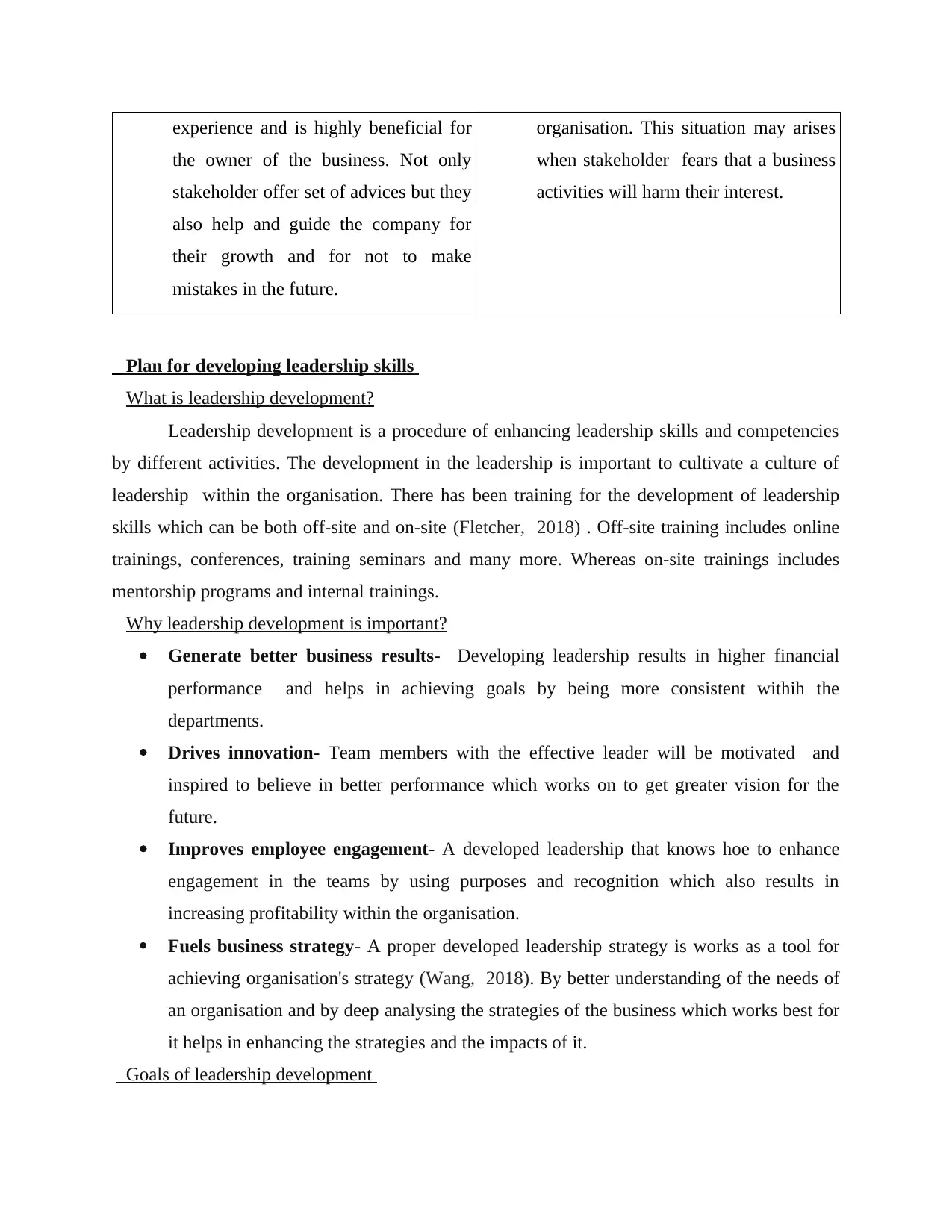
experience and is highly beneficial for
the owner of the business. Not only
stakeholder offer set of advices but they
also help and guide the company for
their growth and for not to make
mistakes in the future.
organisation. This situation may arises
when stakeholder fears that a business
activities will harm their interest.
Plan for developing leadership skills
What is leadership development?
Leadership development is a procedure of enhancing leadership skills and competencies
by different activities. The development in the leadership is important to cultivate a culture of
leadership within the organisation. There has been training for the development of leadership
skills which can be both off-site and on-site (Fletcher, 2018) . Off-site training includes online
trainings, conferences, training seminars and many more. Whereas on-site trainings includes
mentorship programs and internal trainings.
Why leadership development is important?
Generate better business results- Developing leadership results in higher financial
performance and helps in achieving goals by being more consistent withih the
departments.
Drives innovation- Team members with the effective leader will be motivated and
inspired to believe in better performance which works on to get greater vision for the
future.
Improves employee engagement- A developed leadership that knows hoe to enhance
engagement in the teams by using purposes and recognition which also results in
increasing profitability within the organisation.
Fuels business strategy- A proper developed leadership strategy is works as a tool for
achieving organisation's strategy (Wang, 2018). By better understanding of the needs of
an organisation and by deep analysing the strategies of the business which works best for
it helps in enhancing the strategies and the impacts of it.
Goals of leadership development
the owner of the business. Not only
stakeholder offer set of advices but they
also help and guide the company for
their growth and for not to make
mistakes in the future.
organisation. This situation may arises
when stakeholder fears that a business
activities will harm their interest.
Plan for developing leadership skills
What is leadership development?
Leadership development is a procedure of enhancing leadership skills and competencies
by different activities. The development in the leadership is important to cultivate a culture of
leadership within the organisation. There has been training for the development of leadership
skills which can be both off-site and on-site (Fletcher, 2018) . Off-site training includes online
trainings, conferences, training seminars and many more. Whereas on-site trainings includes
mentorship programs and internal trainings.
Why leadership development is important?
Generate better business results- Developing leadership results in higher financial
performance and helps in achieving goals by being more consistent withih the
departments.
Drives innovation- Team members with the effective leader will be motivated and
inspired to believe in better performance which works on to get greater vision for the
future.
Improves employee engagement- A developed leadership that knows hoe to enhance
engagement in the teams by using purposes and recognition which also results in
increasing profitability within the organisation.
Fuels business strategy- A proper developed leadership strategy is works as a tool for
achieving organisation's strategy (Wang, 2018). By better understanding of the needs of
an organisation and by deep analysing the strategies of the business which works best for
it helps in enhancing the strategies and the impacts of it.
Goals of leadership development
Paraphrase This Document
Need a fresh take? Get an instant paraphrase of this document with our AI Paraphraser
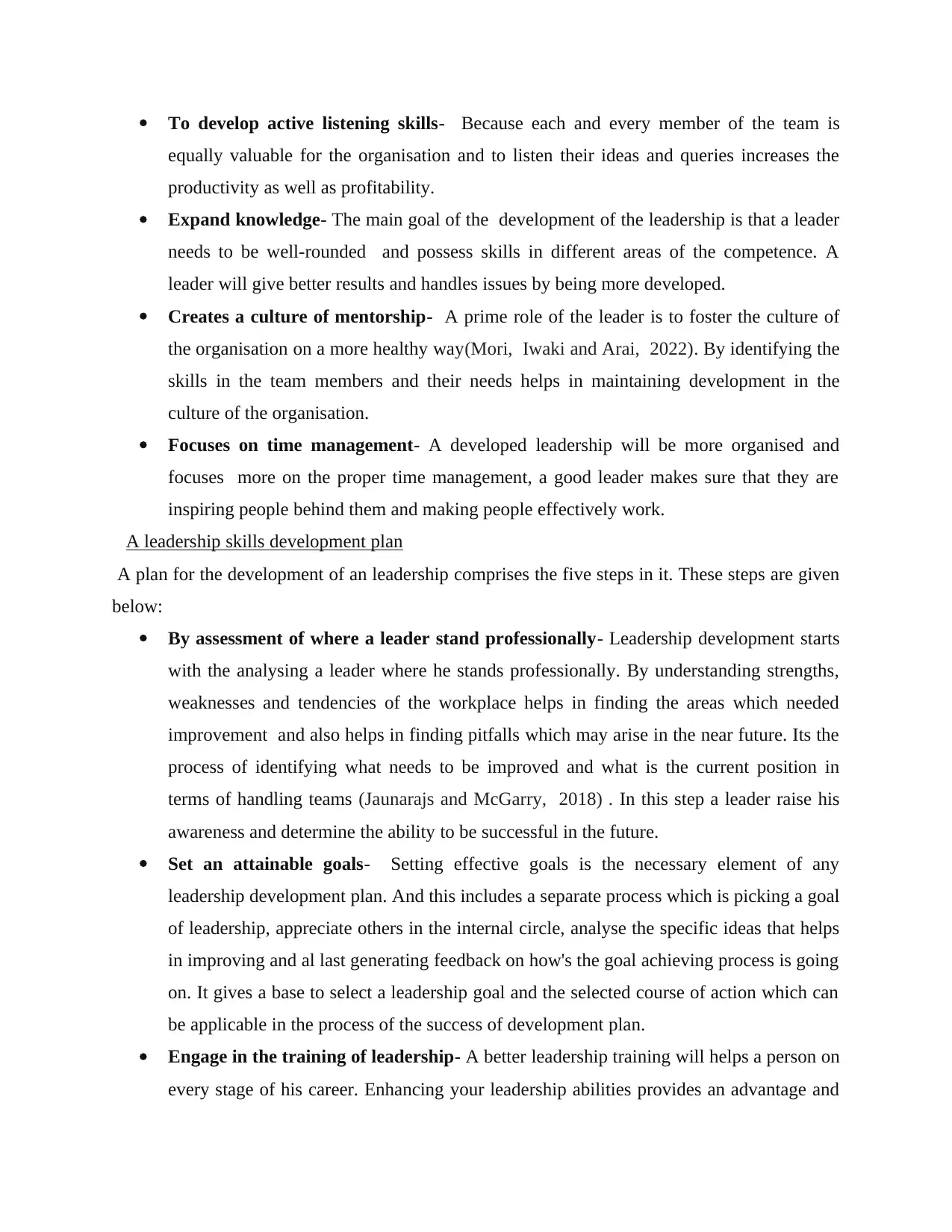
To develop active listening skills- Because each and every member of the team is
equally valuable for the organisation and to listen their ideas and queries increases the
productivity as well as profitability.
Expand knowledge- The main goal of the development of the leadership is that a leader
needs to be well-rounded and possess skills in different areas of the competence. A
leader will give better results and handles issues by being more developed.
Creates a culture of mentorship- A prime role of the leader is to foster the culture of
the organisation on a more healthy way(Mori, Iwaki and Arai, 2022). By identifying the
skills in the team members and their needs helps in maintaining development in the
culture of the organisation.
Focuses on time management- A developed leadership will be more organised and
focuses more on the proper time management, a good leader makes sure that they are
inspiring people behind them and making people effectively work.
A leadership skills development plan
A plan for the development of an leadership comprises the five steps in it. These steps are given
below:
By assessment of where a leader stand professionally- Leadership development starts
with the analysing a leader where he stands professionally. By understanding strengths,
weaknesses and tendencies of the workplace helps in finding the areas which needed
improvement and also helps in finding pitfalls which may arise in the near future. Its the
process of identifying what needs to be improved and what is the current position in
terms of handling teams (Jaunarajs and McGarry, 2018) . In this step a leader raise his
awareness and determine the ability to be successful in the future.
Set an attainable goals- Setting effective goals is the necessary element of any
leadership development plan. And this includes a separate process which is picking a goal
of leadership, appreciate others in the internal circle, analyse the specific ideas that helps
in improving and al last generating feedback on how's the goal achieving process is going
on. It gives a base to select a leadership goal and the selected course of action which can
be applicable in the process of the success of development plan.
Engage in the training of leadership- A better leadership training will helps a person on
every stage of his career. Enhancing your leadership abilities provides an advantage and
equally valuable for the organisation and to listen their ideas and queries increases the
productivity as well as profitability.
Expand knowledge- The main goal of the development of the leadership is that a leader
needs to be well-rounded and possess skills in different areas of the competence. A
leader will give better results and handles issues by being more developed.
Creates a culture of mentorship- A prime role of the leader is to foster the culture of
the organisation on a more healthy way(Mori, Iwaki and Arai, 2022). By identifying the
skills in the team members and their needs helps in maintaining development in the
culture of the organisation.
Focuses on time management- A developed leadership will be more organised and
focuses more on the proper time management, a good leader makes sure that they are
inspiring people behind them and making people effectively work.
A leadership skills development plan
A plan for the development of an leadership comprises the five steps in it. These steps are given
below:
By assessment of where a leader stand professionally- Leadership development starts
with the analysing a leader where he stands professionally. By understanding strengths,
weaknesses and tendencies of the workplace helps in finding the areas which needed
improvement and also helps in finding pitfalls which may arise in the near future. Its the
process of identifying what needs to be improved and what is the current position in
terms of handling teams (Jaunarajs and McGarry, 2018) . In this step a leader raise his
awareness and determine the ability to be successful in the future.
Set an attainable goals- Setting effective goals is the necessary element of any
leadership development plan. And this includes a separate process which is picking a goal
of leadership, appreciate others in the internal circle, analyse the specific ideas that helps
in improving and al last generating feedback on how's the goal achieving process is going
on. It gives a base to select a leadership goal and the selected course of action which can
be applicable in the process of the success of development plan.
Engage in the training of leadership- A better leadership training will helps a person on
every stage of his career. Enhancing your leadership abilities provides an advantage and
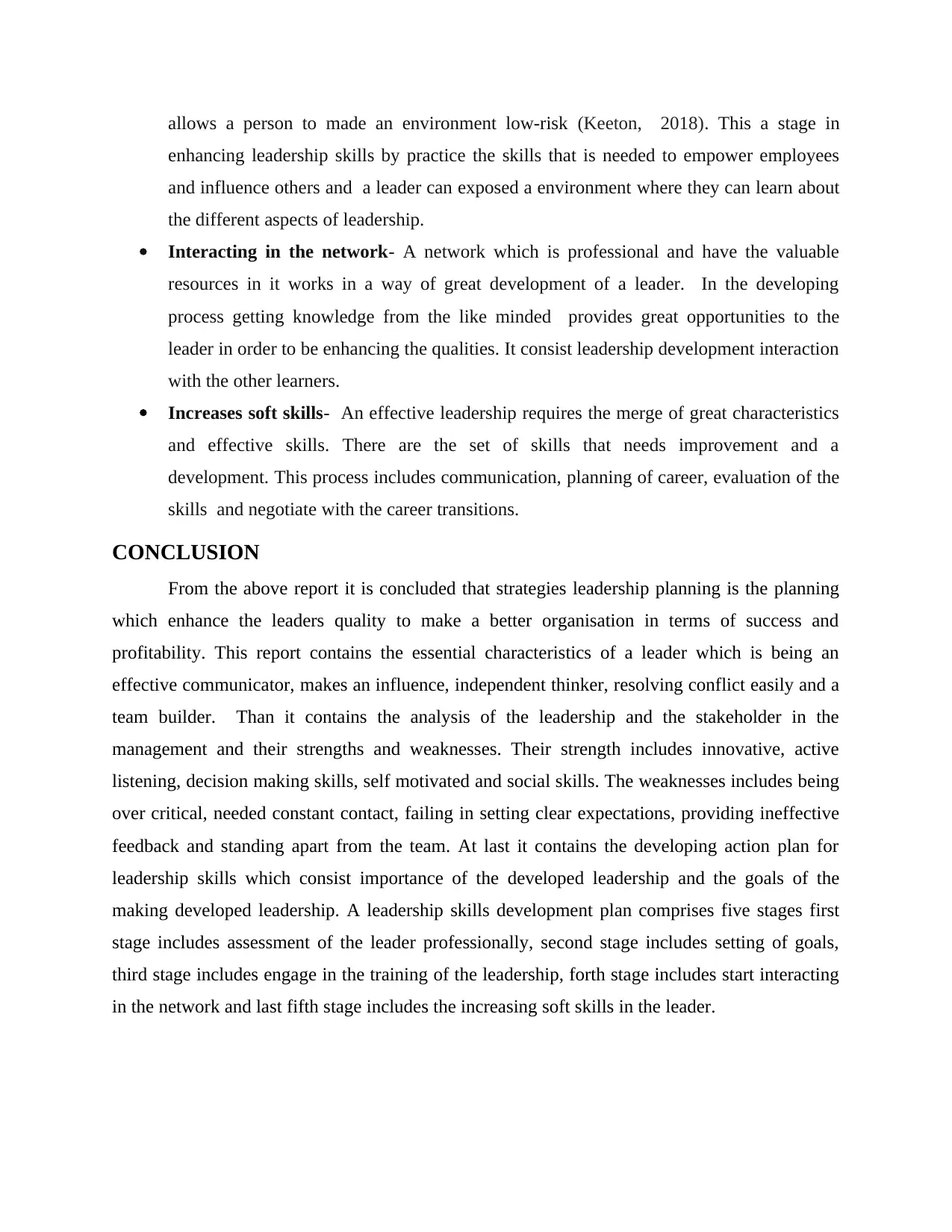
allows a person to made an environment low-risk (Keeton, 2018). This a stage in
enhancing leadership skills by practice the skills that is needed to empower employees
and influence others and a leader can exposed a environment where they can learn about
the different aspects of leadership.
Interacting in the network- A network which is professional and have the valuable
resources in it works in a way of great development of a leader. In the developing
process getting knowledge from the like minded provides great opportunities to the
leader in order to be enhancing the qualities. It consist leadership development interaction
with the other learners.
Increases soft skills- An effective leadership requires the merge of great characteristics
and effective skills. There are the set of skills that needs improvement and a
development. This process includes communication, planning of career, evaluation of the
skills and negotiate with the career transitions.
CONCLUSION
From the above report it is concluded that strategies leadership planning is the planning
which enhance the leaders quality to make a better organisation in terms of success and
profitability. This report contains the essential characteristics of a leader which is being an
effective communicator, makes an influence, independent thinker, resolving conflict easily and a
team builder. Than it contains the analysis of the leadership and the stakeholder in the
management and their strengths and weaknesses. Their strength includes innovative, active
listening, decision making skills, self motivated and social skills. The weaknesses includes being
over critical, needed constant contact, failing in setting clear expectations, providing ineffective
feedback and standing apart from the team. At last it contains the developing action plan for
leadership skills which consist importance of the developed leadership and the goals of the
making developed leadership. A leadership skills development plan comprises five stages first
stage includes assessment of the leader professionally, second stage includes setting of goals,
third stage includes engage in the training of the leadership, forth stage includes start interacting
in the network and last fifth stage includes the increasing soft skills in the leader.
enhancing leadership skills by practice the skills that is needed to empower employees
and influence others and a leader can exposed a environment where they can learn about
the different aspects of leadership.
Interacting in the network- A network which is professional and have the valuable
resources in it works in a way of great development of a leader. In the developing
process getting knowledge from the like minded provides great opportunities to the
leader in order to be enhancing the qualities. It consist leadership development interaction
with the other learners.
Increases soft skills- An effective leadership requires the merge of great characteristics
and effective skills. There are the set of skills that needs improvement and a
development. This process includes communication, planning of career, evaluation of the
skills and negotiate with the career transitions.
CONCLUSION
From the above report it is concluded that strategies leadership planning is the planning
which enhance the leaders quality to make a better organisation in terms of success and
profitability. This report contains the essential characteristics of a leader which is being an
effective communicator, makes an influence, independent thinker, resolving conflict easily and a
team builder. Than it contains the analysis of the leadership and the stakeholder in the
management and their strengths and weaknesses. Their strength includes innovative, active
listening, decision making skills, self motivated and social skills. The weaknesses includes being
over critical, needed constant contact, failing in setting clear expectations, providing ineffective
feedback and standing apart from the team. At last it contains the developing action plan for
leadership skills which consist importance of the developed leadership and the goals of the
making developed leadership. A leadership skills development plan comprises five stages first
stage includes assessment of the leader professionally, second stage includes setting of goals,
third stage includes engage in the training of the leadership, forth stage includes start interacting
in the network and last fifth stage includes the increasing soft skills in the leader.
⊘ This is a preview!⊘
Do you want full access?
Subscribe today to unlock all pages.

Trusted by 1+ million students worldwide

Paraphrase This Document
Need a fresh take? Get an instant paraphrase of this document with our AI Paraphraser
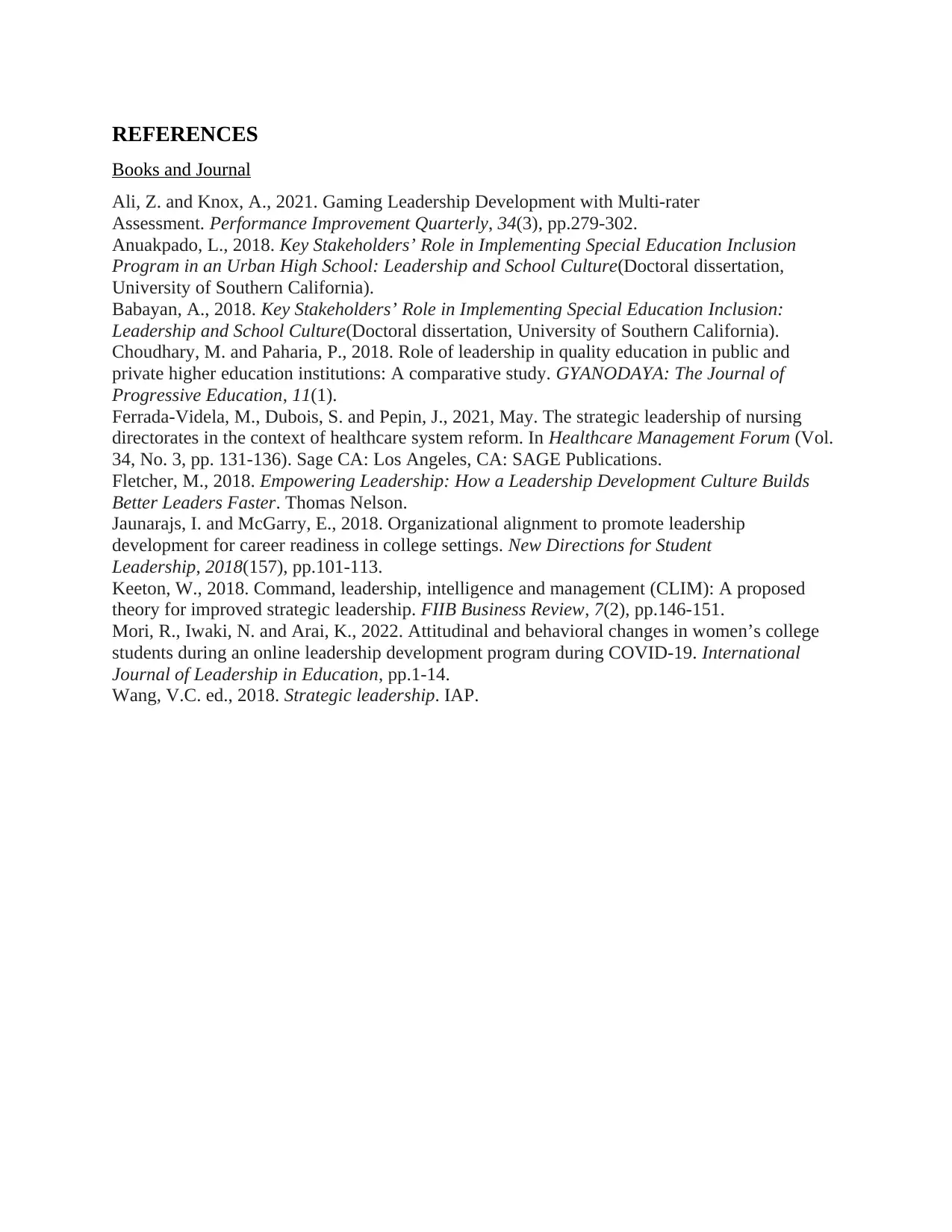
REFERENCES
Books and Journal
Ali, Z. and Knox, A., 2021. Gaming Leadership Development with Multi‐rater
Assessment. Performance Improvement Quarterly, 34(3), pp.279-302.
Anuakpado, L., 2018. Key Stakeholders’ Role in Implementing Special Education Inclusion
Program in an Urban High School: Leadership and School Culture(Doctoral dissertation,
University of Southern California).
Babayan, A., 2018. Key Stakeholders’ Role in Implementing Special Education Inclusion:
Leadership and School Culture(Doctoral dissertation, University of Southern California).
Choudhary, M. and Paharia, P., 2018. Role of leadership in quality education in public and
private higher education institutions: A comparative study. GYANODAYA: The Journal of
Progressive Education, 11(1).
Ferrada-Videla, M., Dubois, S. and Pepin, J., 2021, May. The strategic leadership of nursing
directorates in the context of healthcare system reform. In Healthcare Management Forum (Vol.
34, No. 3, pp. 131-136). Sage CA: Los Angeles, CA: SAGE Publications.
Fletcher, M., 2018. Empowering Leadership: How a Leadership Development Culture Builds
Better Leaders Faster. Thomas Nelson.
Jaunarajs, I. and McGarry, E., 2018. Organizational alignment to promote leadership
development for career readiness in college settings. New Directions for Student
Leadership, 2018(157), pp.101-113.
Keeton, W., 2018. Command, leadership, intelligence and management (CLIM): A proposed
theory for improved strategic leadership. FIIB Business Review, 7(2), pp.146-151.
Mori, R., Iwaki, N. and Arai, K., 2022. Attitudinal and behavioral changes in women’s college
students during an online leadership development program during COVID-19. International
Journal of Leadership in Education, pp.1-14.
Wang, V.C. ed., 2018. Strategic leadership. IAP.
Books and Journal
Ali, Z. and Knox, A., 2021. Gaming Leadership Development with Multi‐rater
Assessment. Performance Improvement Quarterly, 34(3), pp.279-302.
Anuakpado, L., 2018. Key Stakeholders’ Role in Implementing Special Education Inclusion
Program in an Urban High School: Leadership and School Culture(Doctoral dissertation,
University of Southern California).
Babayan, A., 2018. Key Stakeholders’ Role in Implementing Special Education Inclusion:
Leadership and School Culture(Doctoral dissertation, University of Southern California).
Choudhary, M. and Paharia, P., 2018. Role of leadership in quality education in public and
private higher education institutions: A comparative study. GYANODAYA: The Journal of
Progressive Education, 11(1).
Ferrada-Videla, M., Dubois, S. and Pepin, J., 2021, May. The strategic leadership of nursing
directorates in the context of healthcare system reform. In Healthcare Management Forum (Vol.
34, No. 3, pp. 131-136). Sage CA: Los Angeles, CA: SAGE Publications.
Fletcher, M., 2018. Empowering Leadership: How a Leadership Development Culture Builds
Better Leaders Faster. Thomas Nelson.
Jaunarajs, I. and McGarry, E., 2018. Organizational alignment to promote leadership
development for career readiness in college settings. New Directions for Student
Leadership, 2018(157), pp.101-113.
Keeton, W., 2018. Command, leadership, intelligence and management (CLIM): A proposed
theory for improved strategic leadership. FIIB Business Review, 7(2), pp.146-151.
Mori, R., Iwaki, N. and Arai, K., 2022. Attitudinal and behavioral changes in women’s college
students during an online leadership development program during COVID-19. International
Journal of Leadership in Education, pp.1-14.
Wang, V.C. ed., 2018. Strategic leadership. IAP.
1 out of 11
Related Documents
Your All-in-One AI-Powered Toolkit for Academic Success.
+13062052269
info@desklib.com
Available 24*7 on WhatsApp / Email
![[object Object]](/_next/static/media/star-bottom.7253800d.svg)
Unlock your academic potential
Copyright © 2020–2025 A2Z Services. All Rights Reserved. Developed and managed by ZUCOL.



